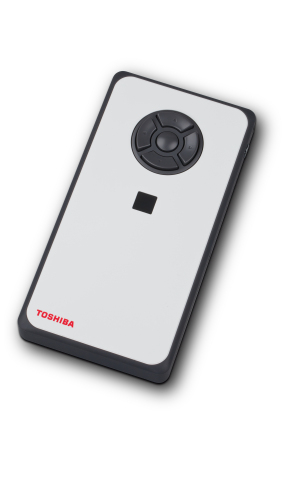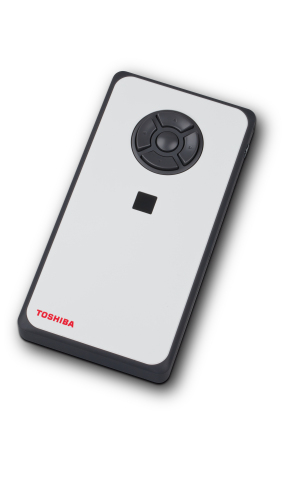
Toshiba Unveils Smartphone-sized PCs For Digital Signage, But Does Anyone Need Them?
August 24, 2017 by Dave Haynes
 Two of Toshiba’s North American business units have announced a pair of smartphone-sized and shaped mini PCs that have that solutions looking for problems air to them.
Two of Toshiba’s North American business units have announced a pair of smartphone-sized and shaped mini PCs that have that solutions looking for problems air to them.
Toshiba’s Client Solutions Division and Toshiba Client Solutions Canada Ltd have released the dynaEdge Mobile Mini PC DE-100 and dynaEdge with Intel Unite solution. The former has an MSRP of $620 and the latter $880.
Says a press release:
Measuring 6.5 x 3.3 x 0.8 inches thin and weighing 10.9 ounces1, Toshiba’s dynaEdge Mobile Mini PC features the power of a 6th Generation Intel® Core™ Processor and the productivity of Windows 10 Pro. This combination creates the ideal solution for constrained industrial and commercial environments, such as embedded control, digital signage, interactive kiosks and mobile applications. While the dynaEdge with Intel Unite® also includes the same Intel® and Microsoft® technologies, it is designed to modernize conference rooms and collaborative workspaces through the adoption of Intel Unite® collaboration software.
“The dynaEdge Mobile Mini PC and dynaEdge with Intel Unite represent our continued expansion beyond the traditional laptop form factor,” said Carl Pinto, vice president, marketing and product development, Client Solutions Division, Toshiba America Information Systems, Inc. “The power and flexibility our newest innovation provides in its compact design appeal to the industrial and commercial sectors looking to implement specialized applications to improve efficiencies and methodologies within their specific businesses.”
Unlike competitive mini PCs, the dynaEdge solution features a replaceable Lithium-Ion battery to create a truly powerful mobile computing solution capable of functioning in any workplace environment. Toshiba designed the dynaEdge with a five-button, on-device Navigation system to enable Up/Down, Left/Right toggles as well as an Enter button. The mobile mini PC is ideal for implementation in applications.
Toshiba developed both dynaEdge solutions to meet the performance demands of the modern workplace through the adoption of 6th Generation Intel® Core™ M Processors, Intel® HD Graphics, Windows 10 Pro, a variety of solid state drive options and up to 16GB of on-board LPDDR3 memory to rival the performance of a contemporary laptop. From a connectivity standpoint, Toshiba equipped both devices with Intel® Dual Band Wireless-AC 8260 802.11ac Wi-Fi®2 and Bluetooth® technologies.
Like all of Toshiba’s business laptops, the dynaEdge is designed, engineered and tested in dedicated Toshiba facilities to deliver greater peace of mind and proven reliability. Toshiba tested the dynaEdge in environments with extreme temperatures, vibration, shock, humidity, altitude, drops, dust and solar radiation.
For the dynaEdge the ability to expand is essential and Toshiba outfitted the solution with the full suite of ports including a USB-C™ port3, USB 3.0 port, a microSD™ Card Slot and headphone/mic combo port. The USB-C port features reversible plug orientation and supports Display out as well as USB 3.1 Gen Data transfer capabilities. Toshiba will bundle the Mobile Mini PC with a USB Wireless Keyboard and Mouse as well as the company’s new USB-C Travel Adapter delivering the following ports: RGB, HDMI, USB and LAN.
Even with an ultra-compact form factor, Toshiba still armed its dynaEdge solutions with an advanced array of security measures, including a security lock port, proprietary BIOS, fingerprint sensor4 and Trusted Platform Module (TPM) 2.0 with Intel® vPro™ technology to help guard against physical theft and data breaches.
So the specs and features suggest very solid, robust and hyper-secure little PCs, and there may well be mobile computing use cases for this, across many lines of business. But PCs got really, really small for digital signage more than 10 years ago when AOPEN started selling PCs that looked a lot like Mac Minis, but could run Windows or Linux. There are now PCs on sticks – whatever you may think of their power and capabilities – that are way smaller than smartphones.
So form factor is not an issue, especially with kiosks that already have enclosure cabinets and stands and will likely evolve to system on chip all-in-one displays, or ones with snap-in PC modules.
The biggest issue here, though, is probably price. There are, of course, specialty jobs in which digital signage player PCs are coming in at $600+, and even $1,000+. But a lot of jobs go out the door with small form factor PCs that cost less than $400 MSRP, and many Android and Chrome OS-based networks are using devices that are sub-$200 and even sub-$100.
And then there are the ostensibly “free” media players in smart displays, with the cost of the system on chip player built in prices by the manufacturers. Those things are using ARM processors that likely cost less than $50.
There was a time – but years ago – when digital signage people mused about the day to come when PC players would be the size of smartphones. I’d need convincing – at least in the context of digital signage screens and kiosks – that many of those people were still waiting.



I agree – what is the purpose? A $99 dollar tablet can do the exact same thing and with a larger screen.
We have discussed that Digital Signage is rapidly racing to a zero price point and this offering seems to be headed in the opposite direction.
Cheap and Simple or it won’t happen.
Paul Wheeler
https://www.sixteen-nine.net/2017/05/09/what-if-managing-digital-signage-content-boiled-down-to-sending-an-email/